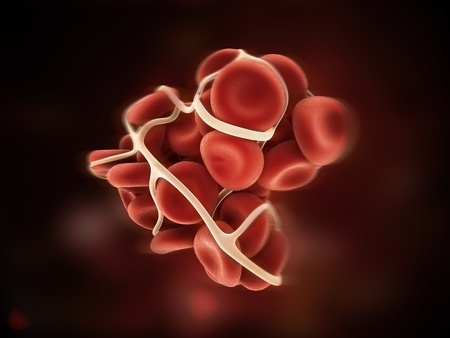 Deep vein thrombosis is a medical condition where blood clots form in veins throughout the body, usually in the deep veins of the legs.
Deep vein thrombosis is a medical condition where blood clots form in veins throughout the body, usually in the deep veins of the legs.Blood clotting, or coagulation, occurs when platelets (a type of blood cell) and specific proteins in plasma (the liquid part of blood) come together to seal off injuries and stop bleeding. Blood clots can also develop when the flow of blood is too slow, damage occurs in the lining of a vein or blood begins to clot too easily.
A deep vein thrombus can develop when a clot forms in a deep vein far below the surface of the skin. When these clots, or DVTs, dislodge and travel through the blood vessels to the lungs, they are called pulmonary embolisms or PEs. This is a very serious medical condition that can be fatal.
Anyone can develop a deep vein thrombosis, but there are certain risk factors that increase the chances of developing a DVT, including:
- Surgery or trauma
- Sitting or lying for long periods of time (bed rest and car or plane trips)
- Pregnancy and the first 6 weeks after childbirth
- Previous DVT
- Use of birth control items containing estrogen
- Hormone therapy use for menopausal symptoms
- Obesity
- Smoking
- Having thrombophilia (blood clotting disorder)
- Advanced age
- Medical conditions such as inflammatory bowel disease, heart failure and some kidney disorders
Those at high risk for deep vein thrombosis may be prescribed medications to prevent blood clots after surgery. Certain medications may also be stopped prior to surgery. Compression stockings and inflatable boots may be applied while in the hospital and getting out of bed and moving is encouraged as soon as possible.
If you are traveling – especially if you are pregnant – your OBGYN may encourage you to increase fluid intake, dress in loose clothing, make regular stops to walk around and wear below-the-knee compression stockings (unless you are diabetic or have circulation problems).
Signs of deep vein thrombosis include pain or swelling in the ankle, calf or thigh. The affected leg may also be warm, red or tender to touch and it may be painful to walk or stand.
If your gynecologist suspects you may have a deep vein thrombosis, tests may be conducted to confirm the diagnosis. These include blood tests, Doppler ultrasound, MRI and venogram.
Drugs used to treat deep vein thrombosis include anticoagulants to prevent clots from forming and, sometimes, to dissolve them.





